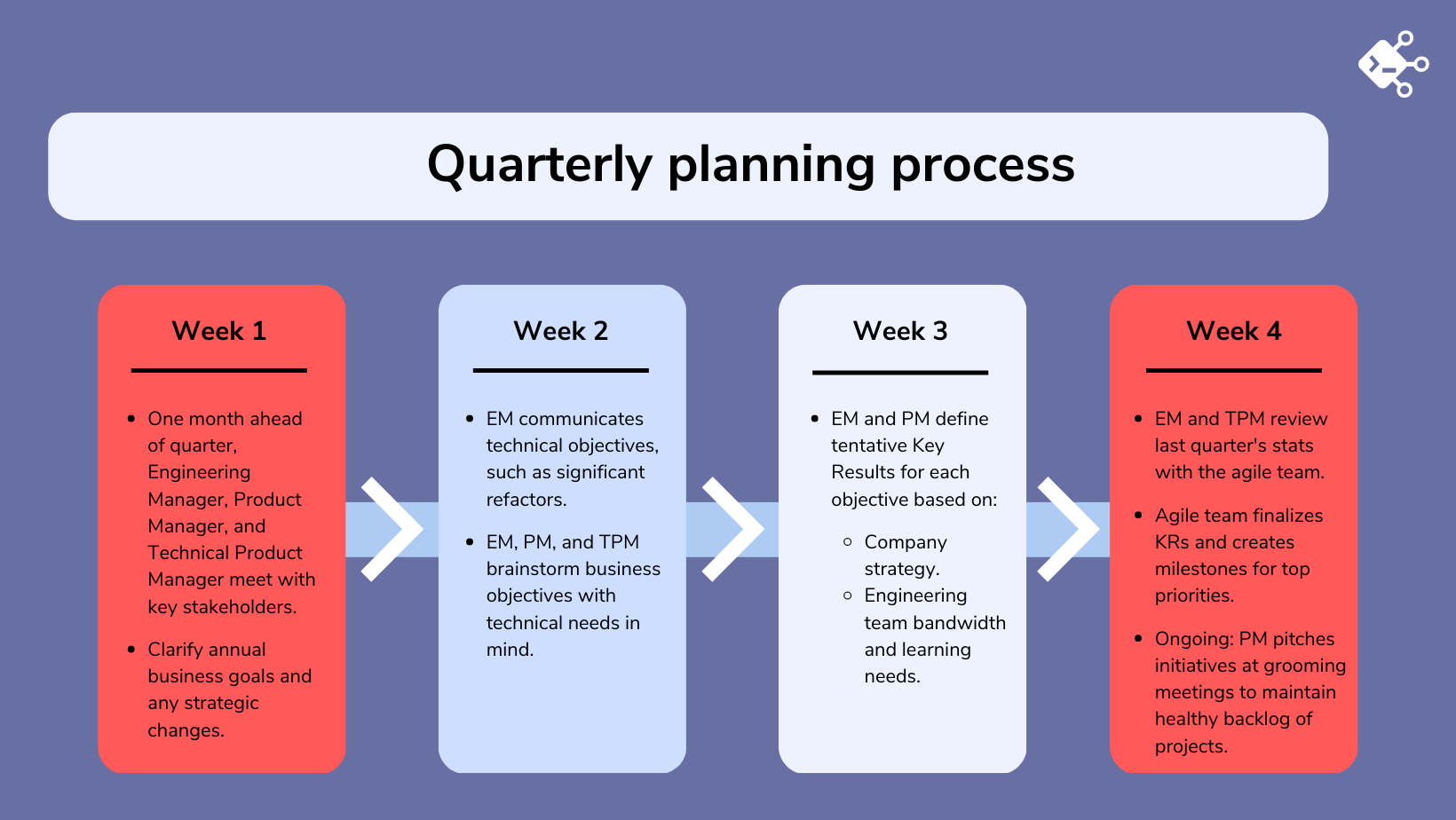Ankur Varshney is a Senior Software Engineering Manager at Scribd. An impact-oriented leader, Ankur enjoys leading teams to success and developing innovative solutions for business issues.
Quarterly planning helps tech companies break down annual business plans into strategic short-term work. Done well, this process enables software engineering teams to deliver on high-impact goals.
Unfortunately, quarterly planning at many companies tends to be product-centric with little involvement from the agile team. This limited input diminishes developer productivity in two key ways:
-
Software engineering teams feel less ownership of quarterly goals.
-
The quarterly goals overestimate developer bandwidth and resources, which can set teams up to fail.
To avoid these pitfalls, I've implemented a 4-week quarterly planning process that facilitates effective communication between the agile team and key stakeholders.
The result: software engineering teams are better equipped and motivated to achieve quarterly goals.
Of course, collaborating on a quarterly plan doesn't mean setting developer work in stone. Markets change, business needs change, and it's important for teams to react quickly to new opportunities. This guide will help you to plan an effective roadmap that you can (and should) deviate from as needed.
Let's break down the quarterly planning process week by week.
Week 1
One month before the quarter starts, the Engineering Manager, Product Manager, and Technical Program Manager meet with key stakeholders: other Product Managers, Design leads, and Business Systems Analysts.
Meeting objective: Understand annual business goals and any strategic changes that have occurred over the last quarter.
Week 2
EM, PM, and TPM brainstorm together to formulate:
-
Business and technical objectives.
-
As an EM, it's important to communicate technical objectives, such as significant refactors, as early as possible. This ensures that stakeholders can balance technical and business goals in future quarters.
-
The level of detail for each objective.
Week 3
EM and PM define tentative key results (KRs) for each objective.
To inform KRs, ask yourselves:
-
What is the company strategy? For example, if the company is focused on growth, your KRs should emphasize growth rather than cost savings.
-
What are the team’s learning needs? Will these KRs help junior engineers to build their skills and provide senior engineers with a meaningful challenge?
-
What is the team's capacity? To keep engineers motivated without causing burnout, set KRs that are just slightly higher than what you believe the team can achieve.
Key results will be finalized after discussion with the rest of the team in week 4.
Week 4
One week before the quarter starts, the EM, PM, and TPM hold quarterly planning meetings. If your teams are remote and dispersed across time zones, you may want to spread these meetings over multiple days.
In addition to the agile team, you may want to include Subject Matter Experts (especially design and analytics) in these meetings.
-
EM and TPM present the last quarter's stats:
-
Overall achievements and successes.
-
Number of epics completed and sizes.
-
Work we could not finish (what we will continue/ discontinue).
-
From there, get the team’s feedback and revise the data as needed. Revisions might include reporting activities that you missed and tabling work that is no longer a priority for your team.
-
The agile team reviews each objective:
-
PM clarifies any questions.
-
The team modifies KRs as needed and creates an updated list.
-
The team organizes KRs by size and impact and identifies risk.
-
Based on capacity from past quarters, the team defines scope.
-
The team translates top-priority KRs into milestones.
-
EM, PM, and TPMs take the agreed-upon KRs to stakeholders and dependencies for final changes.
-
EM, PM, and TPMs present final KRs to the team.

Ongoing: Looking ahead to the next quarter
One of the most important and challenging aspects of quarterly planning is balancing short and long-term goals. It's easy to become so wrapped up in the current quarter that you fail to look ahead—and end up scrambling to generate new ideas.
To maintain a healthy backlog of projects, treat quarterly planning as an ongoing process. The steps we've laid out in Weeks 1-4 should be accompanied by consistent brainstorming.
Here's what that can look like:
-
PM brings initiatives to grooming meetings for effort sizing. This helps:
-
Other PMs reach out to the agile team to get effort estimates for their anticipated work.
-
PMs explain the potential impact of initiatives even if they are not ready for an effort estimate. This gives the team a chance to ask questions and offer new ideas. As a result, the team will feel more engaged and excited about the next quarter.
These meetings will strengthen collaboration between product, engineering, and key stakeholders. As a result:
-
Your team will be more excited about the future.
-
EMs and PMs will be able to communicate the team's potential.
-
Your quarterly plan will align more closely with business needs.
Including the agile team in quarterly planning has made all the difference in my engineering teams' productivity. I hope that you can adapt this approach to reduce the stress of quarterly planning and develop meaningful roadmaps at your organization.
Now that your quarter is underway, don't miss the next crucial step: tracking KRs. You can use this framework to facilitate smooth and impactful sprint reviews throughout the quarter.